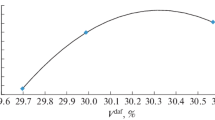Abstract
The maximum gross calorific value of coke corresponds to the >25 mm size class and the minimum value to the <10 mm class, regardless of the quenching method. Dry quenching increases both the gross and net calorific value of the coke in comparison with wet quenching. If the content of gas-group coal in the batch is decreased, the gross calorific value of the coke is increased. For dry quenched coke, the gross calorific value is greater for coke dust than for other size classes (blast-furnace coke, coke nuts, and coke fines).
Similar content being viewed by others
REFERENCES
Spravochnik koksokhimika. Tom 2. Proizvodstvo koksa (Handbook of Coke Chemist, Vol. 2: Coke Production), Rudyka, V.I. and Zingerman, Yu.E., Eds., Kharkov: Inzhek, 2014.
Golubev, A.V., Zbykovskii, E.I., Toporov, A.A., and Shulga, I.V., Povyshenie effektivnosti raboty ustanovok sukhogo tusheniya koksa (Efficiency Improvement of Dry Quenching Systems), Shulga, I.V., Ed., Pokrovsk: Donsk. Nats. Tekh. Univ., 2017.
Filatov, Yu.V., Kovlaev, E.T., Shulga, I.V., et al., Teoriya i praktika proizvodstva i primeneniya domennogo koksa uluchshennogo kachestva (Theory and Practice of Production and Use of Blast Furnace Coke of the Best Quality), Yaroshevskii, S.L., Ed., Kyiv: Naukova Dumka, 2011.
Miroshnichenko, D.V. and Balaeva, Ya.S., Comparison of methods of predicting the higher thermal combustion of coal, Coke Chem., 2011, vol. 54, no. 11, pp. 398–402.
Balaeva, Ya.S., Miroshnichenko, D.V., and Kaftan, Yu.S., Forecast of the gross calorific value of coking coals, Solid Fuel Chem., 2017, vol. 51, no. 3, pp. 141–146.
Miroshnichenko, I.V., Miroshnichenko, D.V., Shulga, I.V., Balaeva, Y.S., and Pereima, V.V., Calorific value of coke. 1. Prediction, Coke Chem., 2019, vol. 62, no. 4, pp. 143–149.
Miroshnichenko, I.V., Miroshnichenko, D.V., Shulga, I.V., and Balaeva, Y.S., Calorific value of coke. 2. Influence of the packing density of the coal Batch, Coke Chem., 2019, vol. 62, no. 6, pp. 234–239.
Miroshnichenko, I.V., Miroshnichenko, D.V., Shulga, I.V., Balaeva, Y.S., and Pereima, V.V., Calorific value of coke. 3. Impact of coal storage periods, Coke Chem., 2019, vol. 62, no. 12, pp. 556–564.
Rudyka, V.I., To the 90th anniversary of the State Institute for the Design of Coke and Chemical Industry Enterprises (GIPROKOKS), Uglekhim. Zh., 2019, no. 3, pp. 3–5.
Drozdnik, I.D., Shulga, I.V., Miroshnichenko, D.V., et al., Evaluation of calorific value of commercial classes of coke, Uglekhim. Zh., 2010, nos. 5–6, pp. 22–26.
Antonov, A.B. and Artyukhov, S.G., Analytical equipment of LECO Company, Nauka Inovatsii, 2013, vol. 9, no. 2, pp. 77–84.
Miroshnichenko, D.V., Kaftan, Yu.S., Desna, N.A., and Sytnik, A.V., Oxidation of bituminous coal. 1. Expansion pressure, Coke Chem., 2015, vol. 58, no. 10, pp. 376–381.
Miroshnichenko, D.V., Desna, N.A., and Kaftan, Yu.S., Oxidation of coal in industrial conditions. 2. Modification of the plastic and viscous properties on oxidation, Coke Chem., 2014, vol. 57, no. 10, pp. 375–380.
Fidchukov, A.L., Khudokormov, A.P., Zhilavyi, P.V., and Shulga, I.V., Evaluation of the efficiency of hot repairs of laying masonry of heating walls, Uglekhim. Zh., 2013, no. 5, pp. 56–59.
PTE-2017. Pravila tekhnicheskoi ekspluatatsii koksokhimicheskikh predpriyatii (PTE-2019. Rules of Technical Operation of Coke Chemical Enterprises), Kharkov, 2017.
Author information
Authors and Affiliations
Corresponding authors
Additional information
Translated by B. Gilbert
About this article
Cite this article
Miroshnichenko, I.V., Miroshnichenko, D.V., Shulga, I.V. et al. Calorific Value of Coke 5. Quenching Method. Coke Chem. 63, 177–182 (2020). https://doi.org/10.3103/S1068364X20040080
Received:
Revised:
Accepted:
Published:
Issue Date:
DOI: https://doi.org/10.3103/S1068364X20040080




